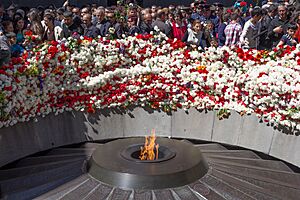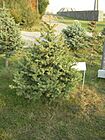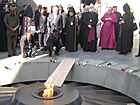Tsitsernakaberd facts for kids

Aerial view of the memorial complex
|
|
| Established | 1967 (memorial) 1995 (museum-institute) |
|---|---|
| Location | Yerevan, Armenia |
| Type | Memorial museum |
| Visitors | ~200,000 (up to 150,000 people excluding 24 April) |
The Armenian Genocide Memorial complex is a special place in Yerevan, Armenia. It was built in 1967 on a hill called Tsitsernakaberd. This memorial honors the victims of the Armenian genocide.
Every year on April 24, which is Armenian Genocide Remembrance Day, many thousands of Armenians visit the memorial. They gather to remember those who lost their lives. People place fresh flowers at the memorial to show their respect. Many important people from around the world, like politicians, artists, and athletes, have also visited this memorial.
The Armenian Genocide Museum-Institute opened in 1995. It helps people learn more about the genocide.
Contents
History of the Memorial
The memorial is located on one of three hills along the Hrazdan River. This hill is named Tsitsernakaberd, which means "swallow's fortress." Long ago, during the Iron Age, there was a fortress here. Even older traces of a castle can still be seen on a smaller nearby hill.
In 2007, archaeologists found parts of a very long wall. They also found large stones that covered graves from about 4,000 years ago. Later, during Roman times, homes were built on these hills.
Why the Memorial Was Built
The idea for a memorial began in the early 1960s. In 1964, some historians suggested building a monument. They wanted to remember the 50th anniversary of the genocide. They also wanted the monument to show the "rebirth of the Armenian people."
The government of Soviet Armenia decided in March 1965 to build a monument. Construction started in 1966. This was after large demonstrations in Yerevan in 1965. During these protests, many people gathered for 24 hours. They wanted the Soviet authorities to officially recognize the genocide. The memorial was finished in November 1967. It was designed by architects Arthur Tarkhanyan and Sashur Kalashyan, and artist Hovhannes Khachatryan.
Design of the Memorial
The memorial has a tall, pointed stone structure called a stele. It is 44 meters (about 144 feet) high. This stele stands for the new beginning of the Armenian people.
Around the stele, there are twelve large stone slabs placed in a circle. These slabs represent the twelve Armenian provinces that were lost. In the middle of this circle, there is an eternal flame. This flame burns constantly to remember the 1.5 million people who died during the Armenian genocide.
Commemoration Wall and Trees
Near the memorial, there is a 100-meter (about 328 feet) long wall. This wall has the names of towns and villages where massacres and deportations happened. On the back of this wall, there are plates honoring people who helped survivors. These helpers included Johannes Lepsius, Franz Werfel, Armin T. Wegner, Henry Morgenthau Sr., Fridtjof Nansen, Pope Benedict XV, Jakob Künzler, and Bodil Biørn.
An alley of trees has also been planted at the memorial. Each tree helps remember the victims of the genocide.
Armenian Genocide Museum-Institute

The Armenian Genocide Museum-Institute opened in 1995. This was for the 80th anniversary of the genocide. The museum was designed by architects Sashur Kalashian and Lyudmila Mkrtchyan, and sculptor F. Araqelyan.
Since it opened, many people have visited the museum. This includes students and tourists from all over the world. Important leaders and figures from other countries often visit the museum as part of their official trips to Armenia. Some famous visitors include Pope John Paul II, Pope Francis, Russian President Vladimir Putin, and French Presidents Jacques Chirac and Francois Hollande.
The museum has many historical documents. It offers guided tours in several languages, including Armenian, Russian, English, French, and German.
Museum Building and Purpose
The museum building has two floors. It is built into the side of a hill. This design helps it blend in and not take away from the main memorial monument. The roof of the museum is flat and covered with concrete tiles. From the museum, you can see the beautiful Ararat Valley and the majestic Mount Ararat.
The first floor of the museum is underground. It holds offices, storage rooms for museum items, a library, and a reading hall. There is also a hall called Komitas Hall, which can seat 170 people. The main exhibits are on the second floor, covering a large area.
The memorial monument is there to remember the victims. The museum's goal is to help people understand the Armenian Genocide. It teaches that remembering the past can help prevent similar terrible events from happening again. The museum believes that if we forget history, we might repeat it.
The institute also does research about the genocide. It publishes books and a journal called International Journal of Armenian Genocide Studies.
Gallery
-
Catholicos Karekin II and Archbishop Rowan Williams during a memorial ceremony
See also
 In Spanish: Tsitsernakaberd para niños
In Spanish: Tsitsernakaberd para niños
- 1965 Yerevan demonstrations
- List of visitors to Tsitsernakaberd
- Armenian Genocide Remembrance Day
- List of Armenian genocide memorials
- Yad Vashem (est. 1953), Holocaust memorial and research institute with a similar concept













